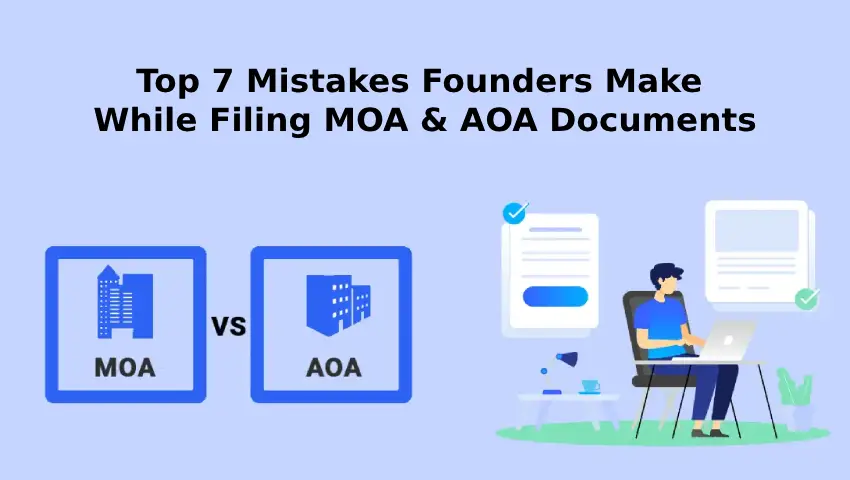
- 13/06/2025
- MyFinanceGyan
- 518 Views
- 2 Likes
- Company Law
Top 7 Mistakes Founders Make While Filing MOA & AOA Documents
Overview Filing MOA & AOA:
Starting a company in India is a big milestone. But while you’re excited to launch, one part that needs special attention is your legal paperwork. Two of the most crucial documents during company registration are the Memorandum of Association (MOA) and Articles of Association (AOA). These aren’t just routine forms—they’re the legal foundation of your business. Unfortunately, many startup founders make avoidable mistakes while filing them.
At My Finance Gyan, we provide updates and valuable information on these processes to help founders stay informed. For professional assistance in filing or documentation, it’s wise to choose trusted service providers like Startup Portal Business Service.
Understanding MOA and AOA:
Before we dive into the mistakes, let’s quickly understand what MOA and AOA are.
The Memorandum of Association (MOA) defines your company’s identity. It tells the government, stakeholders, and the public about your business. It contains key information like the company name, address, capital structure, liability clause, and most importantly, the object clause—which lists your business activities.
These features of MOA are essential for legal and operational clarity. The main clauses of MOA include:
- Name Clause
- Registered Office Clause
- Object Clause
- Liability Clause
- Capital Clause
- Subscription Clause
The Articles of Association (AOA), on the other hand, are the internal rulebook of your company. It lays out the rights, duties, and responsibilities of directors, shareholders, and officers. AOA governs how your company will operate on a day-to-day basis.
The two documents serve different but equally important purposes. The MOA is your company’s charter, while the AOA ensures smooth internal functioning.
Mistake 1: Not Understanding the Purpose of MOA & AOA:
A lot of founders think these documents are just for paperwork and skip reading them. That’s a big mistake. The MOA legally defines what your company can and cannot do. If your activities go beyond what’s written in your object clause, your actions can be considered invalid in the eyes of the law.
Similarly, the AOA ensures your internal operations are governed properly. Ignoring their importance now can create legal complications later.
Mistake 2: Using Generic or Copy-Paste Templates:
Many founders simply download MOA and AOA formats from the internet and file them without making changes. But no two businesses are alike. A SaaS startup and a manufacturing firm can’t operate with the same internal policies.
Using templates without understanding and tailoring them to your specific needs often leads to missing critical clauses or having irrelevant ones. This affects not only operations but can also create trust issues with future investors or partners.
Mistake 3: Choosing Incorrect Business Objects in MOA:
One of the most crucial clauses of MOA is the object clause. It defines your company’s area of work. Unfortunately, many founders either list vague business activities or include too many unrelated ones.
For example, a fintech startup listing ‘agriculture services’ or ‘textile trading’ as a business objective can confuse regulators and investors. It may also delay things like bank account approval, GST registration, or licensing.
Be clear and specific. Make sure your MOA reflects your real business purpose.
Mistake 4: Ignoring Shareholding & Voting Rights in AOA:
When co-founders start a company, everything may seem smooth. But what happens during disagreements or exits? That’s where AOA plays a role.
Founders often forget to include critical details like:
- How voting rights will be distributed
- How shares can be transferred
- What happens if a founder exits or sells their stake
Ignoring these now could lead to legal battles later. So make sure your AOA covers these scenarios in detail.
Mistake 5: Missing Clauses for Fundraising or Exit:
Many startups fail to include future-ready clauses in their AOA. If you’re planning to raise funds later, your AOA should include:
- ESOP frameworks
- Rights issue rules
- Convertible securities
- Exit rights for founders or investors
Without these, you’ll face delays and legal restructuring when an investor shows interest. It’s better to plan for the future from the beginning.
Mistake 6: Not Consulting Legal or Startup Experts:
Filing MOA and AOA is a legal process. But to save costs, many founders do it themselves or get help from unqualified sources. This often leads to mistakes that cost more later.
Consulting a Company Secretary (CS), Chartered Accountant (CA), or legal advisor ensures your documents are structured professionally, use updated formats, and comply with MCA requirements.
Mistake 7: Filing Documents with Errors or Mismatched Info:
Something as small as a spelling mistake in a director’s name or a mismatch between your SPICe+ form and the MOA can lead to rejection from MCA. These errors delay your registration and might even require you to pay additional fees.
Make sure all the documents—MOA, AOA, PAN details, and incorporation forms—match perfectly.
How to Avoid These Mistakes?
Avoiding these errors isn’t hard. You need to be a bit careful:
- Read and understand every clause
- Don’t blindly copy templates
- Add future-ready clauses now
- Hire experts to draft and review your documents
- Double-check all information before submitting
Taking these steps today will save you time, money, and trouble tomorrow.
Conclusion:
Your MOA and AOA are not just compliance documents—they are the building blocks of your startup. From securing funding to scaling operations, these documents will be referenced time and again.
Avoid the common mistakes that most founders make. Plan. Stay updated with expert tips and compliance knowledge through My Finance Gyan. When you’re ready to take the next step, choose Startup Portal for expert help in company registration and legal filings.
Build smart. Build strong. Build right from day one.



